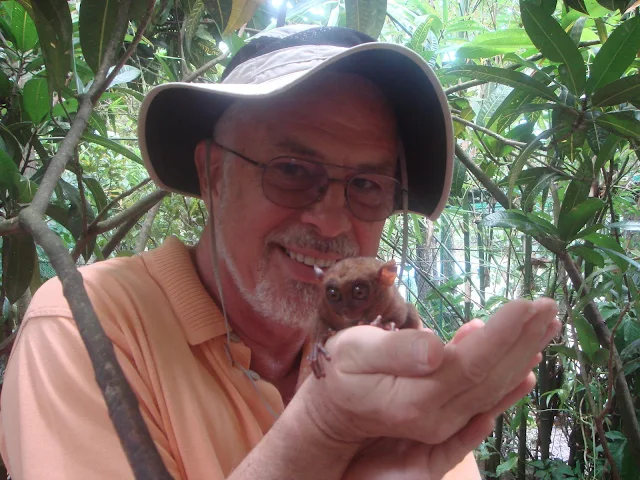The Tarsier - World's Smallest Primate
Tarsiers are haplorrhine primates of the family Tarsiidae, which is itself the lone extant family within the infraorder Tarsiiformes. Although the group was once more widespread, all the species living today are found in the islands of Southeast Asia.
Tarsiers have remarkably large eyes, about 1.6cm. Each eye is bigger than the entire brain and larger than the stomach. So much so that they cannot move their eyes within the sockets. Instead, they special modifications to their neck vertebrae allowing them to rotate their heads nearly 360 degrees, even though they seem to have almost no neck! Unlike most other nocturnal creatures, however, tarsiers do not have a reflective layer behind the eyes (tapetum). They have excellent hearing, using their large funnel-like ears which are hairless, and thin and membranous. They can furl and unfurl their ears.
The Spectral tarsier developed fewer adaptations, e.g., it lacks adhesive toes. Fossils suggest tarsiers ranged throughout Asia, Europe and the Americas. Leaping tarsiers: Tarsiers are outstanding leapers, jumping up to 10 times their body length (2-3m sideways and 1.5m upwards). The longest leap is 5-6m. They look very much like furry frogs! Their hind legs are disproportionately long, almost twice the body length. In fact, they are named for their special elongated ankle (tarsal) bones, in which the tibia and fibula are fused in the lower portions and thus act as shock absorbers.
When they land, they grip strongly with their long and slender fingers and toes, which are tipped with ridged swellings which act like suction cups (in fact, tarsiers can move up glass surfaces with these suckers). The thumb is not opposable but the big toe is.
Their long tail is naked except for few hairs at the tip, and has ridges underneath like the ridges on our hands and feet. They use their tails like a tripod when they are stationary, and to control rotation during their leaps.
They leap quickly through the dense vegetation, often twisting in mid-air. They are vertical leapers and clingers. On the ground they hop like little kangaroos, holding their tails arched over their backs. On the ground, they can make leaps up 1.2-1.7m. To move more slowly, they climb either by hauling themselves up with their front limbs or pushing themselves up with their back legs. They can also slide down a vertical branch on all fours.
Terrible hunters of the night: Tarsiers are pure carnivores, unique among primates. They eat mainly insects (cockroaches and crickets) but also hunt and kill small vertebrates. They even kill venomous snakes, birds larger than themselves (roosting birds are particularly at risk), scorpions and bats. Those living in mangroves also hunt small fish and crabs. Tarsiers are voracious and eat up to 10% of their body weight each day. They often eat all parts of the prey including feathers, beaks, feet, exoskeleton.
They find their prey by sight and through their excellent hearing. They fix onto the prey with their huge soup-plate eyes, rotating their head through 180 degrees if necessary. Their constantly moving radar-dish ears also pin point the location of prey. They stealthily creep up to it, position themselves careful, then capture they prey by leaping with their strong long hind legs. They grab the prey in their strong hands and kill with a few bites of their large, extremely sharp needly teeth, their short muzzle giving them a strong bite. Just before and during the killing strike, they shut their large eyes tightly to prevent injury to their eyes. They then rely on their ears to continue to guide them to the right spot. Tarsiers drink regularly, licking water off vegetation and even going to the ground to lap from a pool or stream. Tarsiers need to be near a source of open water.
Fast Facts about Tarsier
Size: Body 8.5-16cm long, tail 13.5-27.5cm long, 80-165g.
Lifespan: 8-13.5 years. Babies: One young born. Gestation 178 days (rather long for such a small creature), no specific breeding season, maturity at 1 year.
Distribution: Only in Southeast Asia including islands:
Habitat: Only in dense vegetation, usually in lowland rainforest, secondary forests and mangroves. But some like the Western tarsier can be found in cultivated lands and even gardens.
Classification: Family Tarsiidae. There are 3 (some say 4-5) species of tarsier.
Philippines tarsier (Tarsius syrichta): most common in Mindanao, southeastern Philippines and the islands nearby, but also found in Sumatra and Sulawesi.
Western/Bornean/Horsfield's tarsier (T. bancanus): Borneo, Sumatra and Banka
Spectral/Celebes/Sulawesi tarsier (T. spectrum): Sulawesi and nearby Great Sangihe, Peleng and Selajar. Pygmy Tarsier (T. pumilus): central Sulawesi Diana's Tarsier (T. dianae)
Courtesy : http://www.szgdocent.org/
Tarsier Images / Pictures

































0 Comments